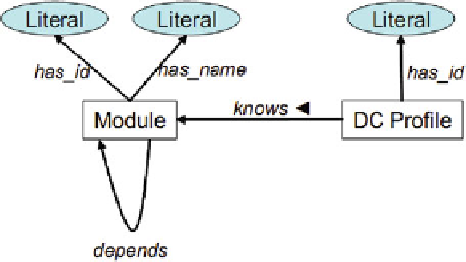Information Technology Reference
In-Depth Information
associating these predicates with the predicates that concern the performability of
the task. For example for the task of editing a file we will define three predicates:
IsEditable(X) :- Editable(X,Y).
Editable(X,Y) :- TextFile(X), TextEditor(Y).
Editable(X,Y) :- EditableBy(X,Y).
The predicates IsEditable and Editable are intentional while the predicate
EditableBy is extensional. This means that a user who can edit a text file with
a module which is not classified as a TextEditor, and wants to define this explic-
itly, he could use the following fact in his profile
EditableBy
(
Readme.txt
,
myProgr.exe
).
8.3 Modelling and Implementation Frameworks
8.3.1 Modelling Conjunctive Dependencies Using Semantic
Web Languages
Semantic web languages can be exploited for the creation of a standard format for
input, output and exchange of information regarding modules, dependencies and DC
profiles. To this end an ontology has been created (expressed in RDFS). Figure
8.14
sketches the backbone of this ontology. We shall hereafter refer to this ontology
with the name COD (Core Ontology for representing Dependencies). This ontology
contains only the notion of DC Profile and Module and consists of only two RDF
Classes and five RDF Properties (it does not define any module or dependency type).
It can be used as a standard format for representing and exchanging information
regarding modules, dependencies and DC profiles. Moreover it can guide the spec-
ification of the message types between the software components of a preservation
information system.
The adoption of Semantic Web languages also allows the specialization of COD
ontology according to the needs. Suppose for example we want to preserve the tasks
Fig. 8.14
The core ontology
for representing dependencies
(COD)

